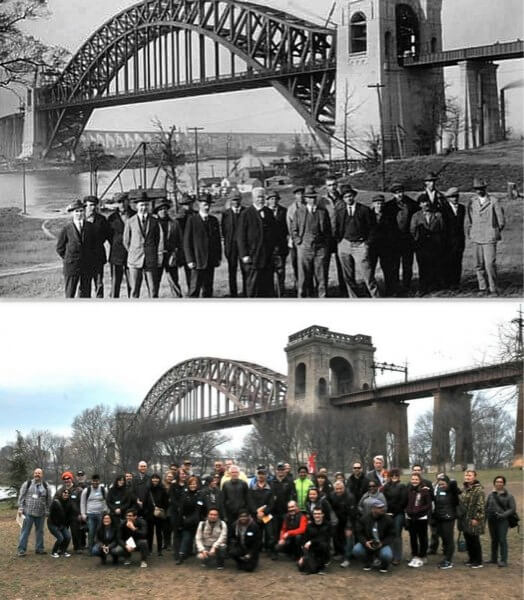By Mark Hallum
Amtrak and the Greater Astoria Historical Society celebrated the 100th anniversary of the construction of the Hell Gate Bridge Monday with not only experts on the history of the railroad overpass, but engineers and thrill-seekers sharing their love for the steel arch that connects Queens to Randalls Island.
The first passenger train made the crossing over Hell Gate in April 1917 after construction was completed as a joint venture between the Pennsylvania and the New Haven Railroads, Deputy Chief Engineer of Structures for Amtrak Jim Richter.
“In those days, the railroads were one of the most powerful and influential businesses in the country because they moved everybody. So, if you study up on the history of the railroads, it was really instrumental in the development of this country,” Richter said.
The right of way was purchased by the Amtrak in the 1970s.
Today, train passenger traveling between New York and Boston still travel over Hell Gate.
Bob Singleton, executive director of the historical society, said the bridge is remarkable for the mastery of engineering that went into it at a time when computers were non-existent and slide-rulers were the builders’ best friend. Singleton compared the decades of work that went into the Second Avenue Subway to Hell Gate, which was built in only a few short years entirely with private capital funds from the railroad companies.
Hell Gate was the work of chief engineer Gustav Lindenthal, who also contributed to the construction to the Hudson River Bridge, among others, around New York City and was widely recognized for his mastery at bridge building.
According to Singleton, Lindenthal was not a civil engineer by formal training. He came from what is now the Czech Republic and his first job was as a bricklayer.
“He revolutionized bridge building,” Singleton said. “And even more significantly than that perhaps is the fact that he trained the next generation of American bridge builders. Othmar Ammann, who was the gentleman who built the Throgs Neck Bridge, the GW Bridge… These guys are getting bridge commissions through the mid-20th century. So not only was this the Hell Gate Bridge being built, it was also a school for American bridge building.”
Dave Frieder has climbed every bridge in the city. Growing up in Flushing, he became entranced with the Flushing Bridge, which was replaced by the Van Wyck overpass.
“When I was a kid on Northern Boulevard, I remember seeing this bridge go up and thinking, ‘Wow, that is so cool!’ Then it came down and all the cars would be going over the closed bridge. That as a kid fascinated me,” Frieder said.
Frieder climbed Hell Gate in the early ‘90s, and spoke of not only the fact that the bridge rises to a much higher than expected height, but the construction is extremely robust. Rivet heads on the George Washington Bridge are only about an inch, he said, but Hell Gates rivets are double the size.
The high carbon Pittsburgh steel the bridge is made out of will last forever, he claimed.
Today, the bridge takes the weight of about 40 Amtrak trains per day while only operating at four-fifths of its full capacity, according to Singleton.
With five tracks and proven strength to carry as many trains at once, the bridge now only operates four tracks at any one time.
Lindenthal had hoped his bridge would be modified to accommodate automobile, light-rail and pedestrians. The towers had passageways built in exactly for this purpose.
But the railroad was not interested in anything but its trains traveling across it, and so Singleton said Hell Gate has never reached its full potential.
Reach reporter Mark Hallum by e-mail at mhall

































